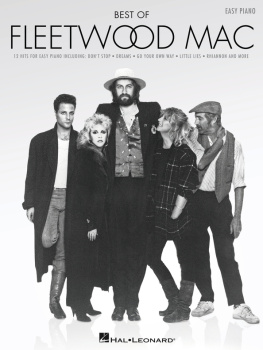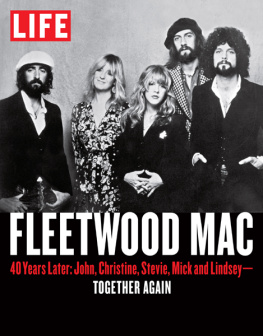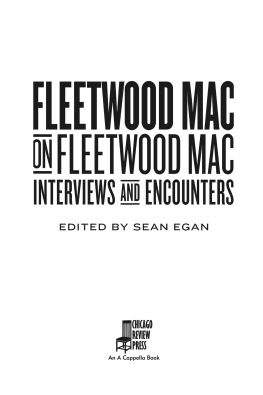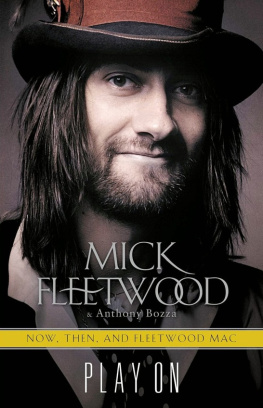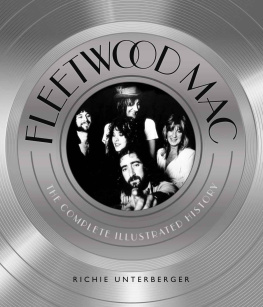Sommaire
Pagination de l'dition papier
OTHER BOOKS IN THE MUSICIANS IN THEIR OWN WORDS SERIES
Bowie on Bowie: Interviews and Encounters with David Bowie
Cobain on Cobain: Interviews and Encounters
Coltrane on Coltrane: The John Coltrane Interviews
Hendrix on Hendrix: Interviews and Encounters with Jimi Hendrix
Judy Garland on Judy Garland: Interviews and Encounters
Keith Richards on Keith Richards: Interviews and Encounters
Led Zeppelin on Led Zeppelin: Interviews and Encounters
Leonard Cohen on Leonard Cohen: Interviews and Encounters
Miles on Miles: Interviews and Encounters with Miles Davis
Springsteen on Springsteen: Interviews, Speeches, and Encounters
Tom Waits on Tom Waits: Interviews and Encounters
Copyright 2016 by Sean Egan
All rights reserved
Published by Chicago Review Press Incorporated
814 North Franklin Street
Chicago, Illinois 60610
ISBN 978-1-61373-237-3
Library of Congress Cataloging-in-Publication Data
Names: Egan, Sean, editor.
Title: Fleetwood Mac on Fleetwood Mac : interviews and encounters / edited by
Sean Egan.
Description: Chicago, Illinois : Chicago Review Press Incorporated, [2016] |
Includes index.
Identifiers: LCCN 2015038135 | ISBN 9781613732342 (cloth : alk. paper)
Subjects: LCSH: Fleetwood Mac (Musical group)Interviews. | Rock
musiciansInterviews. | Fleetwood Mac (Musical group)
Classification: LCC ML421.F57 F54 2016 | DDC 782.42166092/2dc23 LC record
available at http://lccn.loc.gov/2015038135
A list of credits and copyright notices for the individual pieces in this collection can
be found on pages 417420.
Interior design: Jonathan Hahn
Interior layout: Nord Compo
Printed in the United States of America
5 4 3 2 1
This digital document has been produced by Nord Compo.
INTRODUCTION
In 1968 Fleetwood Macs eponymous debutcolloquially known as The Dog and Dustbin LP in reference to its cover photographwas the United Kingdoms bestselling album. Although it boasted fine musicianship, its success was surprising because its music mainly consisted of hardcore blues at a point when the UK blues boom was considered long over.
There was more to the original Fleetwood Mac than blues, however. Their string of classic, groundbreaking singles over the next couple of yearsBlack Magic Woman, Albatross, Man of the World, Oh Well, and The Green Manalishi (with the Two Pronged Crown)covered the waterfront of popular music. This was clearly a remarkable band on more than one level.
Those hits were written by vocalist and virtuoso guitarist Peter Green. Greens colossal talent, though, was like a butterflyhere and gone. By the end of 1970, he was an acid casualty and an ex-member. With fellow guitarist Jeremy Spencers involvement in a cult rendering him also lost to the group, it would seem Fleetwood Mac was finished. Some viewed with skepticism or even contempt the decision by John Mac McVie and Mick Fleetwood to keep the show on the road. The band might have been named after the pair, but only through a moment of whimsy on the part of Green. They were merely bassist and drummer, respectively, and neither wrote songs. In the early seventies, such brand-name-oriented behavior rendered people nothing less than uncool breadheads.
However, the rhythm section laughed all the way to the bank. Moreover, they eventually turned the band into something arguably even more artistically valid than the original lineup. In 1977 a Fleetwood Mac of which only McVie and Fleetwood were original members released an album called Rumours. The album didnt quite match the debuts feat of becoming Britains biggest-selling long-player of its year of issue, but it was up there. More important for the bands finances, it was Americas top album and a bestseller in a host of other countries. Moreover, it was hailed as a cast-iron classic, one of those select records that remain in the charts for years and public affection forever.
Indivisible from the quality, success, and high profile of Rumours is the internal trauma that gave rise to its songs. The bands latest lineup, unusually for the time, was mixed-gender. Keyboardist and songwriter Christine McVie was the wife of John McVie. Guitarist, vocalist, and songwriter Lindsey Buckingham and vocalist and songwriter Stevie Nicks were lovers. In the calendar year preceding the release of Rumours, both couples split. The songs subsequently written by Christine McVie, Nicks, and Buckingham understandably dripped with heartbreak and recrimination, made worse by their obligation to continue to work togetherand indeed play with their ex-partners on songs that were postmortems on their relationships.
As if the bands recordings werent already like diary entries, the Fleetwood Mac members sometimes seemed to use the press like a therapists couch. The ethereal Californian Nicks, the tormented, frustrated punk rocker Buckingham, the dignified English rose Christine McVie, the blunt-speaking John McVie, and the loquacious Fleetwood all regularly had their say and were all astoundingly candid.
Miraculously, the band did not allow their troubles to undermine their career, and this despite an ill-starred affair between Nicks and the married Fleetwood. Instead, for the next decade they continued to release fine music in their thoughtful, melodic style. Double LP Tusk (1979) was perceived as their expensive folly but continues to be highly listenable. Mirage (1982) was a solid mellow effort. Tango in the Night (1987) was burnished adult-oriented rock that constituted a beacon of soulfulness in an emotionally and musically sterile decade.
Buckinghams departure in 87 seemed to bring to a close the era of the Rumours Five. However, he has returned, as have Nicks and Christine McVie despite their own later never-again declarations. Releases by any configuration of the band have become few and far between, and perhaps even irrelevant to large parts of the audiences who flock to the tours Fleetwood Mac continues to mount. However, 2013 and 2014 brought news that made millions ecstatic: the reassembling of the Rumours Five and talk of a new album.
Through interviews across the decades, Fleetwood Mac on Fleetwood Mac examines the groups long, tortured journey: their initial joyous rise; the tragedy of Peter Greens mental deterioration; their struggle to find a new voice with transitory members like Bob Weston, Dave Walker, and Bob Welch; the emotionally troubled but commercially triumphant years of the Rumours lineup; the successive departures of Buckingham, Nicks, and Christine McVie and their respective returns; and the ensembles glide into the twin statuses of senior citizens and Heritage Artists.
It is a saga described in more than one of the features included herein with the ambiguous phrase rocks greatest soap opera. One thing about Fleetwood Macs remarkable history is not ambiguous: this soap opera has the greatest soundtrack of them all.
SEAN EGAN
PETER GREENTHE GUITARIST
WHO WONT FORSAKE THE BLUES
Norman Jopling | August 19, 1967 | Record Mirror (UK)
This is one of the earliest pieces of Fleetwood Mac press exposure, published before Peter Greens Fleetwood Mac had even released a record and before the name of the band had impressed itself on the consciousness of even those who knew about them: Jopling refers to them as Fleetwood Wing.
An example of just how early is provided by the revelation that its inconceivable to their lead vocalist/lead guitarist/guiding spirit Peter Green that the group might ever abandon the blues. Herein, he virtually accuses Eric Clapton of selling out on that scorerather ironic considering that Clapton famously left the Yardbirds two years previously over the alleged abandonment of their blues roots.








